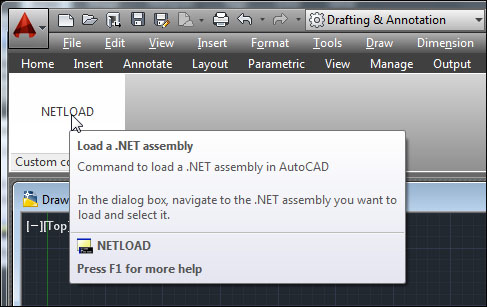Using the .NET API, we'll add a custom button to the AutoCAD ribbon interface. At this point, I've grown tired of typing NETLOAD every time I want to load a .NET assembly. Instead, I want to define a custom button on the ribbon that I can click on and execute the NETLOAD command.
There are two common approaches to customizing the AutoCAD ribbon. One involves creating a partial CUIX file, and the other uses the .NET API to modify the ribbon at runtime. This being a book about the AutoCAD .NET API, we will focus on the latter.
First, let's designate
ID_CUSTOMCMDSas the internal name for our custom ribbon tab, and add some methods for adding and removing the custom tab. In this example, our tab will contain a panel which holds a single custom button. The button will include a two-level tooltip:using System; using Autodesk.AutoCAD.Runtime; using Autodesk.AutoCAD.Windows; using Autodesk.Windows; using Autodesk.AutoCAD.EditorInput; using System.Collections.Generic; // This line is not mandatory, but improves loading performances [assembly: CommandClass(typeof(Ch9AcadPlugin.MyCommands))] namespace Ch9AcadPlugin { public class MyCommands { //Declare the custom tab name here private const String TAB_ID = "ID_CUSTOMCMDS"; public void delRibbon() { Autodesk.Windows.RibbonControl rbnCtrl = Autodesk.AutoCAD.Ribbon.RibbonServices. RibbonPaletteSet.RibbonControl; //Check for the custom ribbon tab and delete for (int i = 0; i < rbnCtrl.Tabs.Count; i++) { if (rbnCtrl.Tabs[i].Id.Equals(TAB_ID)) { rbnCtrl.Tabs.Remove(rbnCtrl.Tabs[i]); return; } } } //Add the custom ribbon tab and panel public void addRibbon() { Autodesk.Windows.RibbonControl rbnCtrl = Autodesk.AutoCAD.Ribbon.RibbonServices. RibbonPaletteSet.RibbonControl; //Add custom ribbon tab RibbonTab rbnTab = new RibbonTab(); rbnTab.Title = "Custom commands"; rbnTab.Id = TAB_ID; rbnCtrl.Tabs.Add(rbnTab); //Add custom ribbon panel addRbnPnl(rbnTab); //Set the custom ribbon tab active rbnTab.IsActive = true; }Next, we'll add the ribbon panel, button, and tooltip, in that order. Label the panel Custom commands:
//Add the custom ribbon panel, button, and tooltip //for the built-in NETLOAD command private void addRbnPnl(RibbonTab rbnTab) { //Add ribbon panel source Autodesk.Windows.RibbonPanelSource rbnPnlSrc = new RibbonPanelSource(); rbnPnlSrc.Title = "Custom commands"; //Add custom ribbon panel RibbonPanel rbnPnl = new RibbonPanel(); rbnPnl.Source = rbnPnlSrc; rbnTab.Panels.Add(rbnPnl);Add a button to the panel. Label the button to read NETLOAD, and set the
CommandParameterproperty toNETLOADas well://Add custom ribbon button Autodesk.Windows.RibbonButton rbnBtn = new RibbonButton(); rbnBtn.Text = "NETLOAD"; rbnBtn.CommandParameter = "NETLOAD "; rbnBtn.ShowText = true; rbnBtn.CommandHandler = new AdskCommandHandler();Add an expanded tooltip to the button. This tooltip has two levels of content. One which displays immediately when you hover with the cursor, and one which displays after a brief delay:
//Add custom ribbon tooltip Autodesk.Windows.RibbonToolTip rbnTT = new RibbonToolTip(); rbnTT.Command = "NETLOAD"; rbnTT.Title = "Load a .NET assembly"; rbnTT.Content = "Command to load a .NET assembly in AutoCAD"; rbnTT.ExpandedContent = "In the dialog box, navigate to the .NET assembly you want to load and select it."; rbnBtn.ToolTip = rbnTT; rbnPnlSrc.Items.Add(rbnBtn); }Now add a method to register the assembly, so the custom button persists the next time you start AutoCAD:
//Register the assembly public void AppReg() { //AutoCAD registry key Microsoft.Win32.RegistryKey regKeyAcad = Microsoft.Win32.Registry.CurrentUser.OpenSubKey( Autodesk.AutoCAD.DatabaseServices. HostApplicationServices.Current. UserRegistryProductRootKey); //AutoCAD Application key Microsoft.Win32.RegistryKey regKeyAcadApp = regKeyAcad.OpenSubKey("Applications", true); //Check whether app is registered string appName = System.Reflection.Assembly.GetExecutingAssembly(). GetName().Name; String[] subKeys = regKeyAcadApp.GetSubKeyNames(); foreach (String subKey in subKeys) { if (subKey.Equals(appName)) { regKeyAcadApp.Close(); return; } } //Get app location and full name string appPath = System.Reflection.Assembly. GetExecutingAssembly().Location; string appFullName = System.Reflection.Assembly. GetExecutingAssembly().GetName().FullName; //Add registry key for addin Microsoft.Win32.RegistryKey regKeyAddin = regKeyAcadApp.CreateSubKey(appName); regKeyAddin.SetValue("DESCRIPTION", appFullName, Microsoft.Win32.RegistryValueKind.String); regKeyAddin.SetValue("LOADCTRLS", 14, Microsoft.Win32.RegistryValueKind.DWord); regKeyAddin.SetValue("LOADER", appPath, Microsoft.Win32.RegistryValueKind.String); regKeyAddin.SetValue("MANAGED", 1, Microsoft.Win32.RegistryValueKind.DWord); regKeyAcadApp.Close(); }Likewise, add a method to unregister the assembly. Make this one a command method, to allow us to unregister it from the command line:
//Command to unregister the assembly [CommandMethod("AppUnreg")] public void AppUnreg() { //AutoCAD registry key Microsoft.Win32.RegistryKey acadKey = Microsoft.Win32.Registry.CurrentUser.OpenSubKey( Autodesk.AutoCAD.DatabaseServices. HostApplicationServices.Current. UserRegistryProductRootKey); //AutoCAD Application key Microsoft.Win32.RegistryKey acadAppKey = acadKey.OpenSubKey("Applications", true); //Delete registry key string appName = System.Reflection.Assembly. GetExecutingAssembly().GetName().Name; acadAppKey.DeleteSubKeyTree(appName); acadAppKey.Close(); }Add a handler to execute a command when the button is clicked:
public class AdskCommandHandler : System.Windows.Input.ICommand { public bool CanExecute(object parameter) { return true; } public event EventHandler CanExecuteChanged; public void Execute(object parameter) { RibbonButton rbnBtn = parameter as RibbonButton; if (rbnBtn != null) { //Execute command specified in ribbon button parameter Autodesk.AutoCAD.ApplicationServices. Application.DocumentManager.MdiActiveDocument. SendStringToExecute((String)rbnBtn.CommandParameter, true, false, true); } } }Finally, add an event handler to notify us when the ribbon becomes initialized, so we can add our custom tab:
using System; using Autodesk.AutoCAD.Runtime; using Autodesk.AutoCAD.ApplicationServices; using Autodesk.AutoCAD.DatabaseServices; using Autodesk.AutoCAD.Geometry; using Autodesk.AutoCAD.EditorInput; using Autodesk.Windows; // This line is not mandatory, but improves loading performances [assembly: ExtensionApplication(typeof(Ch9AcadPlugin.MyPlugin))] namespace Ch9AcadPlugin { public class MyPlugin : IExtensionApplication { void IExtensionApplication.Initialize() { if (Autodesk.Windows.ComponentManager.Ribbon == null) { //Load custom ribbon on startup. Register //ItemInitialized event for when ribbon becomes //available Autodesk.Windows.ComponentManager.ItemInitialized += new EventHandler<RibbonItemEventArgs> (ComponentManager_ItemInitialized); } else { //If ribbon control is available, add custom ribbon MyCommands MyCmds = new MyCommands(); MyCmds.AppReg(); MyCmds.addRibbon(); } } void ComponentManager_ItemInitialized(object sender, RibbonItemEventArgs e) { //Is ribbon available? if (Autodesk.Windows.ComponentManager.Ribbon != null) { //If so, add custom ribbon MyCommands MyCmds = new MyCommands(); MyCmds.addRibbon(); //Delete ItemInitialized event handler – //no longer needed Autodesk.Windows.ComponentManager.ItemInitialized -= new EventHandler<RibbonItemEventArgs> (ComponentManager_ItemInitialized); } } void IExtensionApplication.Terminate() { // Do plug-in application clean up here } } }
We first check to see whether the AutoCAD ribbon has been initialized before adding our custom tab, button, and so on. We then define a custom tab, panel, button, and tooltip. Then, when the user clicks the button, a handler executes the command that we specified in the button's CommandParameter property.




